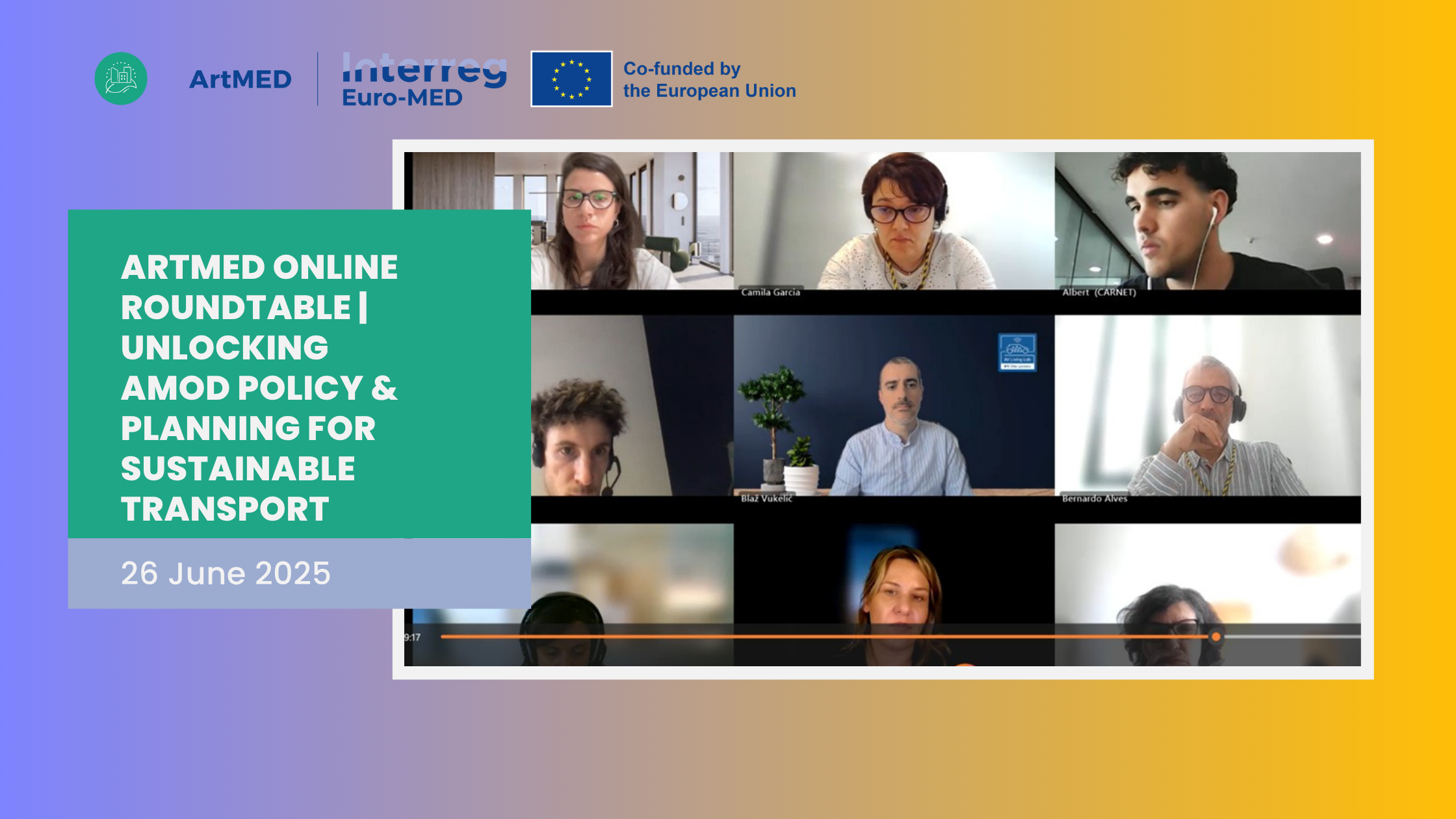Unlocking AMOD: Highlights from the 1st ArtMED Online Roundtable
On 26 June 2025, the ArtMED project hosted its first online roundtable, bringing together participants from across the Euro-MED region for a focused discussion on how Autonomous Mobility on Demand (AMOD) can support more inclusive, intelligent, and sustainable transport systems — particularly in rural and peri-urban areas.
The session featured contributions from four expert speakers representing academia, public transport agencies, private-sector innovation, and consulting. Through short interventions and a moderated discussion, participants explored key issues around planning, policy, financial viability, and real-world implementation of AMOD.
Why AMOD?
As Europe moves toward climate-neutral and digitally enabled mobility systems, many regions, particularly those with low population density, face the ongoing challenge of inefficient or unavailable public transport services. AMOD offers a flexible, tech-driven alternative that responds to real-time demand and local needs.
But how realistic is AMOD as a scalable solution? And what conditions are required to make it viable, accepted, and impactful?
These were the guiding questions of the roundtable.
Speakers & Key Insights
🔹 Prof. Miquel Estrada – UPC, Spain
Opening the discussion, Prof. Estrada tackled the financial sustainability of AMOD and DRT services.
He emphasized that most traditional DRT systems are not economically viable at scale unless they are fully automated and strategically deployed in low-demand zones. He also pointed out the mismatch between service costs and willingness-to-pay, and noted that public authorities often lack the tools to assess viability before launching a pilot.
“We need a new logic — not just replicating fixed-line systems, but designing AMOD with the cost structure, demand, and technology in mind.”
🔹 Viktoria Zorba – Rhoé Urban Technologies, Greece
Viktoria focused on planning and investment strategies, with a special emphasis on controlled environments such as airports or campuses.
She underlined that AMOD success depends on early demand assessment, clear objectives, and the social acceptance of new technologies. Importantly, she argued for starting small, testing with real users, and using learnings to shape larger-scale deployment.
“Airports offer a great testbed for AMOD — you know where people are, what their needs are, and can manage infrastructure and users more directly.”
🔹 Martina Carra – Agenzia TPL Brescia, Italy
Bringing a real-world case to the table, Martina presented the “Sirmione Chiama Bus”, an active DRT service in a tourist area on Lake Garda.
Originally designed to replace an underused fixed-line service, the AMOD system has gained traction among local residents. She highlighted both successes and challenges, including the importance of flexibility, driver training, and digital inclusion, especially for elderly passengers.
“You have to combine operational efficiency with user friendliness — especially for people who may not be digitally literate.”
🔹 Blaž Vukelić – AV Living Lab, Slovenia
Blaž shared insights from AV Living Lab’s ecosystem in Ljubljana, where autonomous and connected mobility solutions are tested in real-life conditions.
He stressed the importance of involving all stakeholders from the start, including policy-makers, municipalities, and citizens. He also advocated for stronger EU-level regulation and standardisation to avoid fragmented deployment and ensure public safety and trust.
“We can’t just look at the tech — AMOD needs a complete ecosystem, from infrastructure to education and legal clarity.”
Discussion Highlights
The panelists engaged in a short moderated dialogue covering:
-
When and where AMOD makes sense: not everywhere, but highly relevant in remote, seasonal, or campus-based contexts
-
The role of public authorities: as enablers, not just regulators — they need the tools, knowledge, and partners to lead
-
Citizens at the centre: communication, inclusion, and expectation management are crucial to long-term adoption
-
Data and digital readiness: both at the municipal and user level, are key enablers or barriers
The ArtMED Perspective
This roundtable is part of ArtMED’s broader mission to explore how AMOD can be tested, evaluated, and implemented in a way that matches local needs and policy frameworks. The discussion validated several directions the project is pursuing:
-
The need for a feasibility assessment tool for local authorities (currently under development)
-
The importance of aligning technical innovation with planning processes and user realities
-
The relevance of cross-country exchange to compare experiences, challenges, and enablers
Thank You
The ArtMED team would like to warmly thank all speakers, participants, and project partners for their contributions to this dynamic exchange.
The full recording of the roundtable is available on our YouTube channel.
Stay tuned for upcoming resources, pilot updates, and publications — and follow us on LinkedIn to stay connected.


